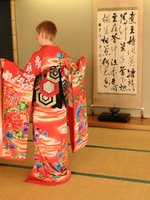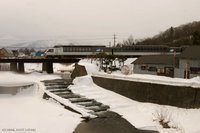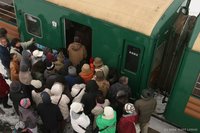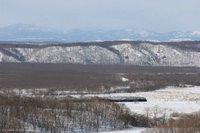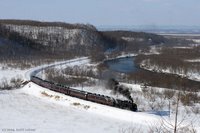With 220 yen, plenty of time, and even more patience, you can ride nearly anywhere in Kyoto on a city bus. Our first attempt went over without problems, thanks largely to the tourism bureau’s English bus map and a straight, one-bus shot down Marutamachi-dori, the busy avenue that ran in front of Kyoto Cheapest Inn. We exited the bus in a western suburb, beside the parallel JR line’s Hanazono station, and began walking north.
Our morning destination was Kinkaku-ji, the Golden Temple (we decided to save Kiyomizu-dera for the afternoon), but we were taking the long way to get there: 4 km of winding back streets in Kyoto’s western hills. Just a block north of Marutamachi-dori, our route took us straight through a sprawling temple and monastery complex. There were no admission fees, no souvenir shops and no crowds. Besides us, the only people out on this drizzly, gray morning were a few Japanese tourists and the long-robed monks, going about their morning rites. We strolled slowly and quietly through the length of the grounds, leaving only for the promise of so much more to see in the day.
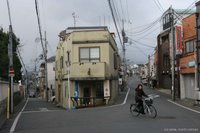
Our path took us through narrow streets and across a single-track railway with one-car trains edging through the backyards of houses, villas and apartment buildings. We turned right and made our way up a winding road at the base of a hill, passing several small temples and countless roadside mini-shrines with little stone gods adorned in bright red New Year’s jackets. The growing crowds along the sidewalk alerted us to our arrival at Kinkaku-ji’s entrance (Y400). While Mo visited the restroom, I discovered the ultimate combination of the Japanese fixations with photography and convenience: a vending machine selling disposable cameras.

Once inside, we were immediately greeted by one of the most famous sights in Japan: the three-story temple with its top two floors in shimmering gold. A special area, apart from the main path, was roped off for the express purpose of viewing and photographing the temple. A man approached with his camera and asked me to take his picture. I complied, then suggested he check the shot on his review screen to make sure it was okay.
“I’m sure it will be okay,” he smiled, pointing to my 20D. “When I want my picture taken, I always look for someone with an extravagant camera.”
With my “extravagant camera,” I took the standard, touristy photos of the temple reflected in the pond beside it, but found greater pleasure in taking pictures of Japanese tourists taking pictures of the temple with their cell phones.

The original Kinkaku-ji dates from 1397, built as a retirement home for Shogun Ashikaga Yoshimitsu and converted into a temple by his son. Of course, we weren’t looking at the original Kinkaku-ji. Lonely Planet reports that “in 1950, a young monk consummated his obsession with the temple by burning it to the ground.” The current edition is a 1955 reconstruction, an exact replica save for the gold-foil covering being extended down to the second floor (only the top story was gold on the original).
“If that guy loved it so much,” Mo asked, “why on earth would he burn it down?”
“I have no idea,” I replied, “but that seems to be the way with obsessions. Why do serial killers murder the people who most fascinate them?”
Beyond the temple itself, there proved little else to see at Kinkaku-ji. While there was one primary path at Nijo-jo, there we were still free to wander about at our leisure. Here, we were guided like so many cattle in stock pens around the grounds. Beyond the temple, we passed a small waterfall, then climbed some stairs to the lake that fed it. In short order, the pathway dumped us out through the exit gate into a hive of gift shops, and that was that. We were welcome to enter again on our same tickets, but I could see little reason to do so. It was only 10:30, none of the ramen shops we had passed on the street outside opened before 11:00, so we boarded a bus to take us back into the city.
Following lunch, we hopped a subway bound for downtown. Two days of hard walking were taking their toll, and rather than exiting for the 1.5 km walk to Kiyomizu-dera, we continued by subway to the main railway station, where we could catch a bus that would take us nearly to the temple’s entrance. That decision proved monumental.
In front of the JR station is the busiest bus stop I have ever seen. On six lanes between covered platforms, each one with multiple boarding points, a ceaseless parade of city buses marched out of and back into the rush of city traffic. A towering sign in front of the platforms listed the color-coded, numbered boarding point for each numbered bus. We found ours and waited, with three dozen other passengers, on the appropriate, narrow swath of platform by an electronic sign that displayed how many stops away the next bus was.
The bus that comes closest to Kiyomizu-dera is no. 206, a circulator bus that runs a loop around downtown. We stood in the crowded aisle as the bus lumbered into the nearly grid-locked midday traffic. Fifteen minutes and only a couple stops later, we were beginning to think we should have just walked from the nearest subway station. Then I noticed the shadows seemed to be on the wrong side of the bus.
“Don’t look now, Sweetie, but I think we’re going the wrong way.”
The next street sign, thankfully including romaji (the Romanized version of written Japanese), confirmed it. City bus numbers in Japan correspond only to the route, not direction. We needed the counterclockwise 206, but had boarded the clockwise one, which was taking the very long way around to Kiyomizu-dera.
“How long will it take if we just stay on this one?” Mo asked.
I consulted my bus map. “At this rate, the temple just might still be opened by the time we get there.” It didn’t close for another five hours.
“I don’t want to be on this bus any more!”
“Me neither. Up for some walking?”
“I think so.”
We exited directly across downtown from the temple and started walking, along the way passing the subway stop that we could have used some 40 minutes earlier. Another kilometer brought us to the bus stop that we had wanted, and from there we began climbing the narrow streets up the hill towards the temple.
The road split, giving us a choice of two routes. Both were crowded with tourists and New Year’s pilgrims, but we selected the somewhat quieter path. Halfway up, we stopped for a break by the entrance to one of the countless souvenir shops along the way.
“Do you mind if I take a few photos while you browse here?” I asked Mo.
I went a short ways back down the hill while she entered the shop. Inside, she looked with half-interest at a rack of Hello Kitty key chains with the expressionless feline adorned in geisha-style kimonos. Across the store, a Japanese voice muttered, “Only an American would buy those!” Mo turned from the display rack to look outside. And there they were.
I was looking downhill, contemplating the low-angled sunlight and long shadows of the narrow street, when Mo’s voice brought me back to reality.
“Scott! SCOTT! Turn around!”

I looked up the hill and saw Mo. Then I looked beside her. A small crowd was timidly following every clip-clopping step of three white-faced women in bright, capacious kimonos. I lowered my camera. This was something to see with my own eyes, not looking through a viewfinder. Beneath the piles of jet-black hair wound tightly on their heads, the make-up was thick and cracking, not as perfect as I had imagined. Reality never is. They took short, quick steps down the hill in high, wooden sandals, heels hanging over the backs, passing not three meters in front of me. The red ribbons in their hair indicated they were maiko-san, geisha-in-training. I turned to watch them go and snapped a single photograph.
Mo was beside me. “My visit to Kyoto is complete!” She beamed.
“Just think,” I pondered as we continued up the hill, “if we hadn’t gotten on the wrong bus, we never would have seen them.”
------------------------------
From here, for the interest of keeping this blog semi-up-to-date, I’ve resigned to continuing with a more basic, condensed narrative of the rest of this trip.

We spent the afternoon at Kiyomizu-dera, a spectacular wooden temple built on stilts clinging to the hillside of its beautiful surroundings. We returned to the station in the evening and dined on okinomiyaki, a delicious grilled pancake of cabbage, eggs, potatoes, and about anything else you might like. The Wall Street Journal reports that okinomiyaki is coming to the U.S. Maureen and I will be glad to still be able to have it when we return, but are already imagining how it could fall short of the Japanese version.

We spent the next day in Arashiyama, a picturesque western suburb of Kyoto where Hozu-gawa (the Hozu River) tumbles out of a narrow fold between two mountains. We wandered the streets and paths along the river, dined at a noodle shop beside the falls where we watched a high school karate class practice in the river on that chilly, 5C day, ate green tea flavored ice cream (not bad, an interesting bittersweet taste) at another riverside shop, then set off up the winding streets through bamboo groves, shops and temples at the foot of the western hills. At the top, where some buildings still sported thatched roofs, we caught a bus back into town, retrieved our bags from Kyoto Cheapest Inn, and caught a train on the Hankyu Railway back to Osaka.

There, we stepped off the platform and into the rush of Osaka nightlife, where the neon glow, punk rock music and masses of people moving in every direction offered a stark contrast to refined, traditional, cultural Kyoto. Outside the station, a maze of overhead walkways carried pedestrians above the rush of traffic in the streets below. On these, photographers sold prints and postcards, musicians played guitars and sang, and bands – full bands – set up with speakers, amps and drum sets to jam with the rhythm of the surging traffic and the rush of commuter trains.
We could have spent the whole night taking it all in, but we had to find dinner and our overnight bus to Tokyo. There was no proper bus station, but rather a simple bus stop from which all the buses left, from inner-city circulators to the long distances night runs. Beside it, we found a newly opened Italian restaurant that filled us up for Y2000.
On board the bus, by far the cheapest way to travel between the Kansai region and Tokyo, we had the two seats located directly behind the driver, offering both a little extra legroom and a fabulous view of the night-lit city through the big front windows.
The next morning, we once again found ourselves at nothing you would really call a bus station. We were dumped on the sidewalk in the middle of downtown Tokyo at 6am, and expected to fend for ourselves from there. Luckily, we were only two blocks from the train station, where we stashed our bags in lockers, found breakfast, and caught a subway for Tsukiji (Skee-jee), home of the largest fish market in the world.


Nothing can really prepare the first-time visitor for Tsukiji, not even T.R. Reid’s wonderfully written short story “The Great Tokyo Fish Market” in the book TRAVELERS’ TALES GUIDES: JAPAN. You might expect to be led to the place from several blocks away (or turned away from it, as the case may be) by the pungent smell of rotting fish, but that isn’t the case at all. Fish doesn’t come to Tsukiji to rot. It comes to be sold, and delivered to the highest bidder on the double. It’s in and out so fast that it doesn’t have time to stink. And just how much of it passes through on a given day? Reid reported 5 million pounds, and from my observations, I have no reason to disagree with him. For you other rail enthusiasts out there, that’s 2500 tons, or 25 U.S.-sized refrigerated boxcars per day. Except it doesn’t move in boxcars. It moves on thousands of miniature forklifts through the packed, narrow aisles to be sold as individual fillets to the thousands of fish buyers wandering those narrow aisles and inspecting each catch. Behind them, in one of the hundreds of sellers’ booths, two men use a chainsaw to slice up the frozen carcass of a two-hundred pound tuna, while other fish, bigger than me, lay intact on the floors. Eels thrash about in small tanks beside others filled with snapping crabs and floating salmon eggs. Later that same night, it will all be served up, cooked or not, to so many thousand salarymen, tourists, families and students at Tokyo’s countless restaurants and sushi bars. The majority of the market of is open to the public, and it’s up to each individual visitor to stay out of the way. Maureen and I succeeded, sometimes barely, in doing so for thirty all-sensory stimulating minutes, then found our way back to the rest of the world, which, in truth, seemed very much removed from Tsukiji.

From there, we ventured to the western suburbs of Tokyo, where we visited the Ghibli (Gee-blee) Museum, dedicated to Japanese animator Hayao Miyazaki and the history of animation. From there we returned to downtown Tokyo and took a ride on the newly built Yurikamome tramline across the Rainbow Bridge spanning Tokyo Harbor. The trams are fully automated and run without a driver, allowing passengers in the first car a front-row view of the harbor and city. We walked along the waterfront, enjoying the mild weather and the Statue of Liberty look-alike, then headed back through downtown to find our hotel.
We had the train station and phone number for the hotel, but had failed to bring directions. We flagged a taxi and asked for the Toyoko Inn, but the driver seemed to have no idea what were talking about. We tried the next cab and were met with a similar result. At this point, we called the hotel. They did not speak enough English and we did not speak enough Japanese to get directions ourselves, but Maureen did succeed in getting the receptionist to direct the taxi driver. When the taxi dropped us off a few hundred meters down the street, we exited feeling very sheepish.
We hadn’t seen a bed in four nights, and pull of the big one in our room was nearly enough to keep us in for the evening. Eventually though, freshly showered, we struck out to find dinner with a view in the Tokyo night. We returned to the train station, by foot this time, and took a local train to Shinjuku, the next station and pulsating heart of Tokyo’s nightlife. Or, at least, supposedly the pulsating heart of Tokyo’s nightlife. The neon glittered from the train windows, but exiting to street level, we found streets that had largely packed up and gone home for the evening, even though it was only 8:30. Maybe we were in the wrong part of town. We found dinner, though, with a fine view from one of the many restaurants on the 29th and 30th floors of the NS Building, where we spied some salarymen in adjacent high-rises still going strong as 10:00 approached. Our restaurant served dinner up shabu-shabu style, which is a big pot of boiling broth placed on a gas burner in the middle of the table. We then got plates of raw meat and vegetables, which we added to the broth, cooked, and ate at our leisure. This, plus appetizers, dessert and drinks brought the bill to Y8675, or about $75US. Three days’ of all-inclusive travel in China.
We took a wrong turn going back to the train station and fearless navigator Scott failed to listen to the voice of reason walking beside him, beseeching him to retrace his steps to familiar territory. We finally arrived at the station of a private railway which we used to get back to the Japan Rail station, which we used to get us back to our hotel, though an hour or so later than we would have gotten back otherwise.
The next morning, we slept as late as our 10:00 checkout time would allow, then packed out bags and headed into a gray, overcast day.
“What do you want to do today?” I asked Mo.
“I dunno. What do you want to do?”
“I dunno.”
The previous morning, Tokyo held more wonders than we could ever hope to see in a month of two-day visits. One packed day later, our enthusiasm was in the gutter. We browsed a few department stores, laughing at the $100 shirts and $200 skirts. The highlight of the day was the attractive basement bar/café we stumbled into for lunch, where we received a filling bowl of curry rice, salad, dessert and tea for just Y750 each, or about $6.50US.
Downtown, the allure of the streets was no longer there. We looked at shrines and musems in the guidebook and had no interest in finding our way out to them. In the end, we decided to split up for an hour of solitude. I wandered the grounds of the Imperial Palace (built in 1888, rebuilt in 1968 after allied bombers blew up the first one), but was disappointed at the vast expanses of unused gravel parking lots in the middle of such an otherwise developed area. The palace is only open to the public on two days out of the year, January 2 and December 23. No doubt the parking lots are packed on those two days, but in the growing gray dusk of January 6, I would have much preferred a some green garden space.

I found Mo back at the train station and she led me to a mall for dinner. Faced with another all night bus ride, this one to Hachinohe, a nine hour ride to the north, we both lamented not instead making the trip by train, today, in daylight, where we could have enjoyed seeing more of the country. But that decision was already made, and so we wandered through an art exhibit in the mall, sat talking on a quiet bench, and finally made our way to the bus station for another night of inadequate leg room and too little sleep. We once again had seats right behind the driver, but even the night view through the front windows departing Tokyo paled in comparison to Osaka, two nights before.
What we needed was rest, and we found it at Maria’s apartment in Hachinohe. Hachinohe is a Pacific Ocean port city of 100,000 in northern Honshu, and Maria was Maureen’s roommate during the JET orientation in Tokyo back in August. She was more than happy to house us for a relaxing weekend of resting, eating lots of good food, and watching anime, which included the excellent full-length movie Spirited Away, by Hayao Miyazaki.

On Monday morning, Maria gave us a very early ride to the Hachinohe ferry terminal, where we boarded a Rainbow Line ferry for the nine-hour voyage back to Muroran. We spent most of it sleeping on the carpeted floor of our second-class dorm room. We were glad to be back to Muroran, but our time at home was short. We were up early the next morning, Tuesday, for a trip to Sapporo where Maureen was attending a JET conference and other adventures awaited.

